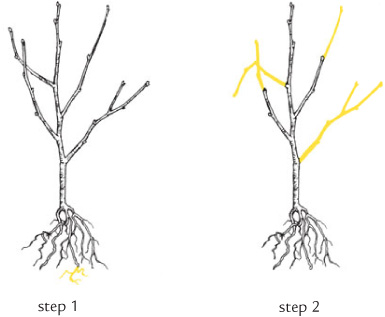
A shade tree is a lifetime project, so choose a location where it can grow to its majestic stature without heavy pruning. Don’t take the term shade tree literally, because it embraces trees like the Lombardy poplar, which actually offers little in the way of shade. Shade trees can (1) define borders, (2) shield a house from noisy highways, (3) provide a protected living or playing area, and (4) offer autumn color, among many other practical and aesthetic purposes. Because large trees are the kings and queens of the landscape, you should place them with care to avoid the need for heavy pruning.
A The term shade tree usually connotes a deciduous tree, although evergreens can also be shade trees. Some evergreen trees are shade trees, as discussed in chapter 7.
Q Can I plant my new tree as it is from the nursery or must I do something to it first?
A The answer to your question depends upon the tree’s packaging and condition at purchase. When you buy a plant, its roots may have been dug with a tight ball of earth and wrapped in burlap or plastic, it may be growing in a pot of soil, or the bare roots may be surrounded only with moist moss. Each kind of packaging requires different care at planting time.
Q How do I plant a balled-and-burlapped tree?
A If your new tree comes with its roots enclosed in a large ball of soil, you probably don’t need to prune much at planting time, except for cutting back a few extra-long or damaged roots emerging from the root-ball. Just be careful not to damage the root-ball as you maneuver it to the hole.
Q How do I plant a bare-root tree?
A If you purchase a small bare-root tree or dig one up in a friend’s yard and transplant it, you should cut off broken roots and damaged branches when you plant. Remember to make your cuts on a slant, just above a bud, and cut to an outside bud on the side branches. Follow these simple guidelines:
1. Prune off any broken roots with a smooth cut.
2. Start pruning for a strong structure during the next dormant season. Remove any damaged wood, leaving a central leader and as much leaf space as possible.

Q How do I plant a container-grown tree?
A The roots of some trees that have been growing for several years in a large container before being sold may circle the outside of the root-ball. If this pattern continues after the tree is planted, the increasing size of the encircling roots can actually strangle the tree in later years. Check the outside roots to see if this strangulation is occurring. If it is, spread out the off ending roots or prune back woody girdling roots and plant the tree in a wide, shallow hole.
Q We lost trees from ice and wind damage last winter. Is there any way we can protect the trees we plant as replacements?
A First, choose the right tree. The trees at a reputable retail nursery should be well on their way to a healthy, strong form thanks to early formative pruning, so there’s not much for you to do. Still, young trees may need occasional pruning to develop a sturdy structure. Trees grown with a single leader are more likely to have a strong trunk and sturdy permanent (scaffold) branches that can withstand harsh weather. Trees with multiple leaders usually have narrow crotches with included bark, which makes limbs more susceptible to ice and wind damage. Training means pruning out weak branches in favor of strong ones over time.
Q How can I train my young shade tree to have a strong form?
A To give your tree the strongest form, train it to a central leader with well-attached branches (scaffolds). The following tips are for training central-leader trees, not trees intentionally grown with multiple trunks.
1. The tree should have a central vertical branch or leader growing above the other branches. You will need to deal with competing leaders — vigorous vertical side branches or secondary trunks nearing the height of the central leader — by shortening the side branches and removing the secondary trunks.
2. Remove weak, crossing, and rubbing branches. Crossing branches create congestion in the tree crown and block sunlight from reaching the limbs. Rubbing wears away the bark, giving pathogens easy entry.
3. No two branches should emerge at the same spot on the trunk.
4. Healthy scaffold branches — the main branches forming the framework of the tree — emerge at different heights and in different locations around the trunk, like spokes on a wheel when seen from a bird’s-eye view. In a large shade tree, the scaffold branches should typically be 12 to 18 inches apart on the trunk.
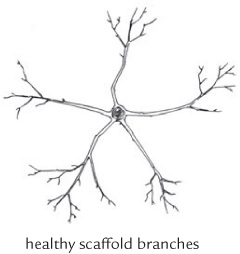
5. The angle between a branch and the trunk is normally strongest between 45 and 90 degrees. Remove branches and multiple trunks growing at acute angles to the main trunk.
6. Over time, remove any bottom branches that would grow so long and heavy that they could break.
Q How long does it take for a tree to develop a strong form?
A Structural pruning takes place during a tree’s first 25 or so years. Ideally, remove problem branches when they’re young and measure less than one-third the diameter of the trunk.
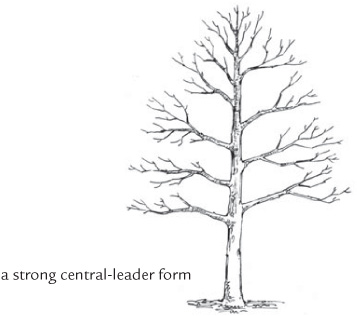
Q We have a gorgeous shade tree in the front yard. It’s about 10 years old. We’ve never done a thing to it. Should we prune it?
A If your tree grows well, significant pruning may not be needed for many years. There are times, however, when you should intervene: Remember the old saying that an ounce of prevention is worth a pound of cure.
PROBLEM 1. Crossed branches develop or the top begins to grow crooked.
SOLUTION. Do some snipping and pinching during the growing season. Wait until the dormant season to do the heavier pruning.
PROBLEM 2. Abundant sucker growth appears from the base of the tree.
SOLUTION. Use a saw or loppers to cut off the suckers, and any weak lower limbs, close to the trunk.
PROBLEM 3. Your tree develops a competing leader.
SOLUTION. Cut out any competing leaders that develop.
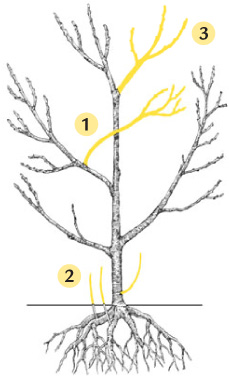
Q When’s the best time to remove a large limb?
A Pruning in late winter or early spring before a tree leafs out may be less stressful for the tree. Also, at this time you can see the structure of a deciduous tree.
Q My oak tree has ugly growths on some of the twigs. What are they, and what can I do about them?
A These abnormal tissue growths are called galls. Leaf, twig, and stem galls look bad but won’t do permanent harm to a tree. Prune out ugly twigs in light infestations, which can be caused by insects such as mites, wasps, aphids, and midge flies. Oaks are particularly susceptible to galls.
Crown galls, caused by a bacterium, are different from the common leaf and stem galls, which are caused by insects. Crown galls form at the soil line on the principal tree roots (and sometimes on lesser roots) or higher on the trunk and branches. Among affected plants are fruit trees such as apple and cherry, nut trees, and shrubs like roses, raspberries, blackberries, and burning bush — about 140 plant genera in all. These galls start out tan, smooth, and spongy but turn hard, rough, and black with age. Effects of this disease range from stunted growth to plant death. The bacterium can enter the plant through grafting or pruning wounds, so when disease is present, it’s crucial to keep tools clean by sterilizing after each cut. First, clean dirt off tools, then dip them in a household disinfectant such as Lysol or rubbing alcohol. Wipe off excess disinfectant before making the next cut.
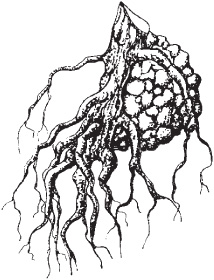
Q Some old trees on my property are in pretty bad shape. Should I take their age into account when I’m pruning them?
A Yes, because trees, like animals and humans, go through various life stages, from infancy to old age. Sooner or later, each tree will reach a stage when it is impractical to spend vast amounts of time and money on it, and you must consider replacement. It may be difficult to make the decision to recycle an old tree as firewood and mulch, but this process is also a part of good gardening and conservation. Old, derelict trees are not only unsightly, but they are also dangerous and harbor insects and disease. Consider these guidelines.
1. When a tree or shrub is young, do corrective pruning: Pinch buds and redirect branches to persuade the plant to grow in a strong, attractive shape.
2. During the prime of its life, a tree or shrub may benefit from corrective pruning and pruning for rejuvenation, production, balance, or usefulness.
3. In a tree’s old age, prune mainly to keep it healthy and prolong its useful life. No amount of pruning can prolong the life of a Lombardy poplar much beyond its anticipated 20 or 30 years, but a bristlecone pine may live for thousands of years without removing a branch. Find out the approximate life span of each plant in order to prune it properly.
4. Adjust your pruning to the plant’s present state of vitality, which varies by age and species, and from year to year depending on soil and weather. Just because a flowering crab apple may thrive from a severe cutback when it is four years old doesn’t mean that it can stand the same treatment at age 40.
Q Can I do structural pruning on old trees?
A If you neglect to do early shaping of a tree and large limbs grow low on the trunk, be sure that the plant has a healthy crown before cutting off any basal branches. Never cut off more than a quarter of the crown or branch area (10 to 15 percent is better) in a year, because leaves are necessary to nourish the tree. You could probably prune a tree 30 feet tall with 25 feet of limb growth 5 feet up from the base of the crown in any one year without endangering the tree.
If several good-sized limbs must be cut off, spread the project over a few years by cutting off only one or two each fall or every other fall. This way, you give the tree time to grow additional leaf mass at the top to compensate for the loss of basal limbs, and you avoid shocking the tree.
Q How can I know whether an old tree that needs lots of work is worth saving?
A If you own a decrepit tree, or if you acquired a sad specimen along with your new home, you should consider if it is worth saving before you spend lots of money to save it. Weather, disease, and insects take their toll, no matter how carefully you plan a tree’s location or perform its initial shaping, and life span varies greatly according to species. Some giant sequoias (Sequoiadendron giganteum) are about 3,500 years old, and trees of many other species in this country are older than the republic. However, some poplar and cherry trees are over the hill by the time they reach the age of 30. Check with your Cooperative Extension Service or consult a certified arborist for information about your specific type of tree.
If your mature cherry tree (Prunus spp.) has an isolated problem, such as a black knot–infested limb, remove it. It’s important to cut carefully, so that you do as little damage as possible to the tree and the surrounding plants and structures. Arborists tie a rope around a limb before cutting it. They make large cuts, as shown on page 62, then ease the limb gently to the ground.
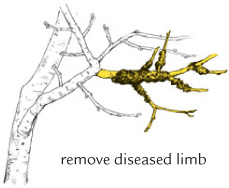
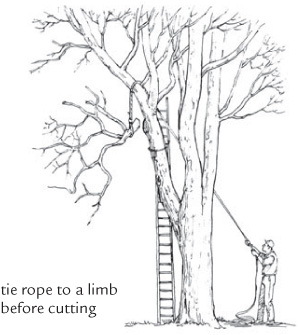
Q I’m worried because a major branch on my Bradford pear tree started splitting off. What can I do to stop it?
A If the tree is old and the crack is deep, get rid of the tree; it’s a danger to people and property. If the tree is young and has two leaders — a likely cause of splitting and cracking — prune one off. For short-lived varieties with naturally poor branching habits like Bradford pear, cables or bolts are not usually recommended.
However, professional arborists may use bracing to secure a heavy, weak, stressed, or splitting limb on other trees. This involves drilling holes through the trunk and limb, and installing cables and/or bolts to provide extra strength. Before pruning or removing a tree, consult with an arborist to see if cabling or bracing can save it.
Q My tree has a big cavity in it. Should I clean it out and fill it?
A Although older trees are most apt to develop big cavities, trees of any age may develop openings or cavities as a result of wood-decay fungi. These hollows make habitats for many bird and small mammal species, and filling them takes away that habitat. In fact, caring for trees differs from caring for your teeth. Although filling a festering tooth helps stabilize the tooth and prevent further decay, filling a tree cavity with cement makes the surrounding wood rot faster. If you’re displeased with the appearance of a hollow, an arborist can fill the cavity with special tree foam that does not affect the tree’s natural movements. An arborist also uses braces and cables to stabilize trees. If your tree cannot be stabilized and endangers people or property, you must remove it.
SAFETY REMINDER
Never prune near electrical or utility wires. Contact your city, town, or utility company to do the job.
Q Big beautiful trees grow around my home. Should I hire someone to prune them or can I prune them myself?
A Tree work can be dangerous, particularly when it involves big, mature trees. Tree climbing and pruning high or heavy branches are dangerous tasks that require skill, time, and training to learn. Trained arborists treat trees with respect. When they use a ladder, they protect the tree by not sliding the ladder along the branches, which would scar the bark. Professionals use a rope to lower pruned limbs and avoid letting them crash into other limbs, people, and property.
For big trees, hire an arborist with credentials from state and national organizations such as the American Society of Consulting Arborists (ASCA), the International Society of Arboriculture (ISA), and the Tree Care Industry Association (TCIA) to do the work. Before hiring an arborist or tree specialist, check the company’s proof of insurance to avoid liability for an accident on your property.